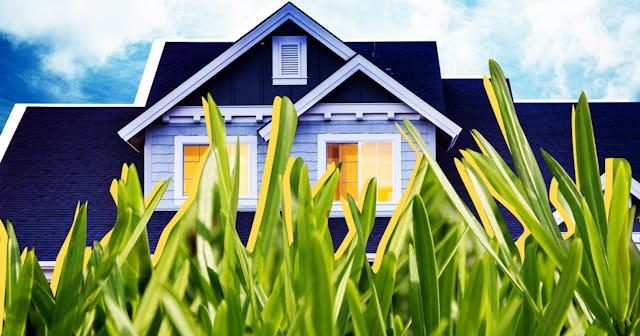Why Folks Are Joining The No-Mow Movement

I am obsessed with my lawn. I love the look of a thick, green, and weed-free space. I also have a degree in horticulture with a focus in sustainable agriculture. I don’t use my degree for professional purposes, but it is handy for personal gardening and landscaping situations. However, in terms of my turf, I realize I am not following the rules I know apply when it comes to living a completely green lifestyle. I’m a partial hypocrite.
But my yard is so pretty. And my OCD brain is happier when the lawn is uniform and manicured. I know Mother Earth is more valuable, but did I mention how pretty my lawn is? I realize pretty comes in a variety of packages. And one of those comes in the no-mow movement.
The maintenance of our lawns comes at a cost. According to Natural Resources Defense Council (NRDC) Americans use 3 trillion gallons of water a year to keep their yard hydrated; lawn mowers eat 200 million gallons of gas and spit out the fumes; and 70 million pounds of pesticides are being poured into the ground each year. Ugh. Not only are we depleting natural resources, we are putting pollutants into the air, ground, and water. Runoff from lawns covered in pesticides and fertilizers gets into our lakes, streams, and oceans. This gets into our drinking water, and the food we eat is being contaminated by our seasonal weed and feed routine.
To reduce their carbon footprint, some homeowners are converting all or part of their lawns to no-mow yards. The NRDC refers to this as a “less thirsty” type of landscape. They suggest four variations: (1) an un-mowed turf that grows naturally and wild; (2) low-growing turf that doesn’t need much attention; (3) native landscapes where native plants and climate-friendly growth built for local seasons replaces turf; and (4) edible plants that replace sections of a yard. These can be vegetables and/or fruits trees and bushes.
The idea is to create space that is more self-sufficient and less reliant on water and chemicals. Believe it or not, global warming is a thing, and as temperatures rise, droughts are more frequent and tend to last longer. It gets hot and before the towns issue water conservation warnings, we drag out the hoses or program the sprinkler systems to keep our lawns from burning. We are using water that is not being replaced. I see the problem with this. I also see the problem with killing weeds like dandelions and wild flowers that benefit pollinators and our food supply. I see the problem with animals, pets, and our kids running through and ingesting pesticide-covered grass.
I can also see homeowners associations (HOA) having a problem with folks just letting their laws go wild and free. So before you get too excited about converting your lawn into a no-mow landscape, see just how far you can stretch the minds of those with the rule books. Yards that are allowed to become naturalized or converted to native plants may be seen as an annoyance or eyesore. Overgrown lawns can also be a fire hazard and recipe for rodent problems and invasive weeds.
Do your homework and start small. Replace a corner of your yard to plant berry bushes. Or add a few raised beds for vegetables and herbs. Turn a section of your yard into a wildflower garden. Even gradual shifts and small changes can help the environment.
Or go big, like this couple. Hillary Wyon and her partner Paul Williamson acquired a lawn that had been owned by people of a “Roundup mentality.” They considered a moss lawn and looked into drought-tolerant grasses, but ultimately planted mint, chamomile, and thyme. Wyon says, “It’s really soft, low-growing greenery. And when you walk on it, the leaves get crushed and produce fragrance.”
I know, I know. I can’t see myself doing this either. However, I do allow my backyard to be a bit more natural, i.e., full of weeds. I keep the front and sides looking sharp, but between the dogs and the kids, a crabgrass-filled backyard is fine. Weeds need less water and as long as there is grass for my kids to play on, they are happy. I also use natural pesticides and do most of my weeding by hand. I know it’s not to the extent of going full no-mow, but I am going to keep my yard the way I like while being as environmentally friendly as possible.
Is there more to my obsession than just aesthetics?
Bruce Butterfield, a senior researcher for the National Gardening Association in Burlington, Vermont, says this: “Lawns are often about self-image; the identity with a manicured lawn suggests higher status. People think of golf courses and country clubs and mansions. The big fertilizer companies really play into this with their commercials. The message is: If you have dandelions in your lawn, you’re a bad person; you’re lazy and you’re an eyesore in the neighborhood and you should be ashamed of yourself.”
For me, it really just comes down to my need for perfection. I wasn’t kidding when I said my OCD plays a role in my lawn care. Pulling weeds becomes obsessive and causes a lot of anxiety. Between kids running around sticky and half-naked, and bikes and soccer balls littering the driveway and sidewalk, higher status is not something I am suggesting with my lawn. I’m just grasping for a little bit of control over my living space.
If you don’t want to make any changes to your yard but want to be more eco-friendly, an electric mower, compost bin, or rain barrel are also ways to make yard care more sustainable. Start small; every little bit counts.
This article was originally published on